
Pyramidal orchids by Paul Lane
Jon Hawkins - Surrey Hills Photography

Pyramidal orchids by Paul Lane
Pyramidal orchids are fairly widespread in the UK. You often see them growing in roadside verges (another good reason to stop mowing!) as well as chalk grassland, their more typical habitat. Look out for them coming into flower this month.
Living up to its name, the orchid’s densely packed flower spike has a distinctive pyramid shape, made up of up to 100 individual flowers ranging in colour from pale to deep pink. They are pollinated by day- and night-flying moths, and butterflies.

Nightjar by David Tipling/2020Vision
Nightjars migrate to the UK every year from sub-Saharan Africa to breed. They’re here from May to September and the best time to see – or more likely hear – them is now.
The birds are most active at dusk, when they catch flying insects in mid-air. The male nightjars call for mates by churring loudly from the tops of trees. We’re holding two nightjar walks at the end of the month on 28 June at Windsor Great Park and 29 June at Greenham Common – come along for a chance to hear these special birds!
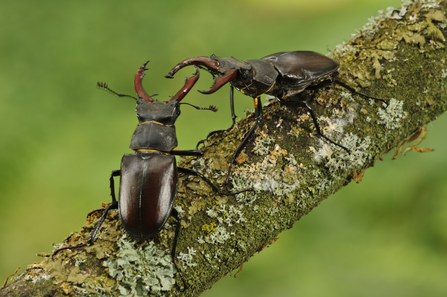
Stag beetles by Terry Whittaker/2020VISION
Look out for stag beetles flying around on warm evenings in June. These are one of our largest beetles and are named after the males’ fearsome jaws, which are said to resemble the antlers of a stag – and, just like the deer, they will use them to fight off male rivals.
The adults are short-lived (no more than a couple of months), but their larvae spend several years hidden underground where they feed on rotting wood. Look for them on woodland edges, in hedgerows, parks and gardens.
Froglet by Richard Burkmar
One of the greatest joys of any summer has to be watching tiny baby frogs emerging from a pond and hopping onto dry land for the first time.
Tadpoles generally start developing legs in May, when they shift from a vegetarian to a carnivorous diet to get vital extra protein.
By June, the earliest tadpoles will have completely metamorphosed, and warm, wet nights are a great time to head to a pond with a torch and look for emerging froglets and toadlets. Our CS Lewis Nature Reserve in Oxford is the perfect place to look.
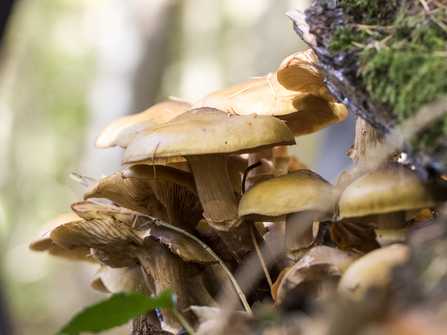
Honey fungus, photo by Chris Lawrence
Fungi spend most of their life beneath the surface, but one species that emerges to reproduce in June is the honey fungus.
These golden mushrooms sprout in clumps from stumps, roots and fallen branches, and grow up to 15cm in diameter in the moist woodlands at our Warburg Nature Reserve near Henley.

Black hairstreak by Roy Macdonald/Lakes4Life
Black hairstreaks are one of the UK’s rarest butterflies, found only in thickets of blackthorn in woodlands and along hedgerows, between Oxford and Peterborough.
They can be seen on several BBOWT nature reserves, including Finemere Wood, Rushbeds Wood, Whitecross Green Wood, Asham Meads and Bernwood Meadows. (Take care not to trample the wild flowers at these reserves when looking for butterflies.)
Black hairstreaks lay their eggs on mature blackthorn. BBOWT manages blackthorn hedges carefully so that there is always a variety of height and depth within a hedgerow, from new shoots to mature trees.
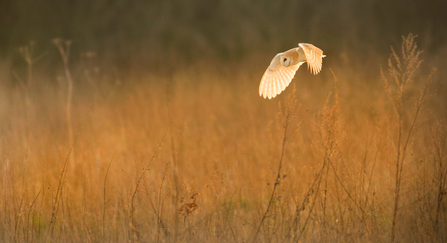
Jon Hawkins - Surrey Hills Photography
The beautiful barn owl, with its pure white feathers and heart-shaped face, is perhaps our most-loved owl.
Females usually lay clutches of about four eggs in April or May and they start hatching a month later. The middle of June is a great time to look for the new parents hunting in the daytime for mice to feed their voracious chicks – look out at our Chimney Meadows reserve in West Oxfordshire.
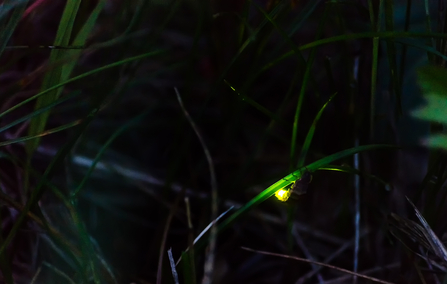
Glow worm by Wikipedia Commons
These famous insects are actually a type of beetle, and it is the wingless females that glow: they cling to grass stalks on warm summer nights and produce a greenish light from their abdomens. The winged males fly around searching for these emerald invitations.
We are very lucky to have a population at Whitecross Green Wood a few miles north of Oxford – well worth a night out!

Otter by Luke Massey
Keep an eye out for otters if you’re walking along the River Thames this summer. The Thames Path through Chimney Meadows nature reserve is a good place to catch a glimpse of them, or you can try to spot their spraint (otter dung). You might also see them as you walk through Cholsey Marsh, another riverside reserve.
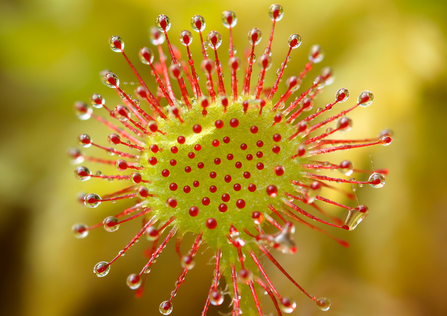
Round-leaved sundew by Paul Olive, Sole Common Pond, Berkshire
A carnivorous plant, the sundew lures insects to their doom with leaves that are covered in sticky droplets of 'dew' which glisten like nectar. This dew is actually a glue that traps the hapless victim: glands on the leaf then release acids that dissolve the insect's body before the plant reabsorbs the nutrient-rich liquid.
Crimson-coloured, round-leaved sundews grow in boggy areas at several BBOWT reserves, including Snelsmore Common near Newbury.
The stunning photo above by Paul Olive was one of our winning pictures in last year’s photography competition. The 2024 competition is now open for submissions – click here for more information and to enter your wildlife shots.